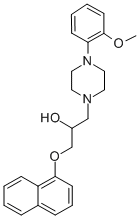Naftopidil , ≥98.0% , 57149-07-2
Synonym(s):
4-(2-Methoxyphenyl)-α-[(1-naphthalenyloxy)methyl]-1-piperazineethanol hydrochloride hydrate;KT-611
CAS NO.:57149-07-2
Empirical Formula: C24H28N2O3
Molecular Weight: 392.49
MDL number: MFCD00242741
EINECS: 692-531-5
| Pack Size | Price | Stock | Quantity |
| 5G | RMB99.20 | In Stock |
|
| 25G | RMB248.80 | In Stock |
|
| 500g | RMB1975.20 | In Stock |
|
| others | Enquire |
PRODUCT Properties
| Melting point: | 127 °C |
| Boiling point: | 517.2°C (rough estimate) |
| Density | 1.1592 (rough estimate) |
| refractive index | 1.6300 (estimate) |
| storage temp. | Sealed in dry,Room Temperature |
| solubility | methanol: >10 mg/mL |
| form | solid |
| pka | 14.01±0.20(Predicted) |
| color | white |
| Merck | 14,6356 |
| CAS DataBase Reference | 57149-07-2(CAS DataBase Reference) |
Description and Uses
Naftopidil was launched in Japan for the treatment of dysuria associated with benign prostatic hypertrophy (BPH). It can be prepared by a two step route starting with α-naphthol. Naftopidil is a potent postsynaptic-selective alpha-l-antagonist with a slightly higher affinity for the human prostatic than for the aortic alpha-adrenoceptor. It also shows a 5-HT1A agonistic effect, as well as a weak calcium antagonistic activity, but no alpha-2 or beta-adrenoreceptor affinity. In experiments with rats or rabbits, Naftopidil was shown to be more potent and selective for the urodynamic effect than the hypotensive effect. Aromatic or aliphatic hydroxylation are the major routes of metabolism, producing metabolites with a profile similar to the parent compound.
A α-1-Adrenergic receptor antagonist, antihypertensive.
Safety
| Symbol(GHS) |  GHS08 |
| Signal word | Warning |
| Hazard statements | H361 |
| Precautionary statements | P201-P202-P281-P308+P313-P405-P501 |
| RIDADR | 3077 |
| WGK Germany | 3 |
| RTECS | TL9336500 |
| HS Code | 29335990 |
| Toxicity | LD50 in mice, rats (g/kg): 1.3, 6.4 orally (Himmel) |


